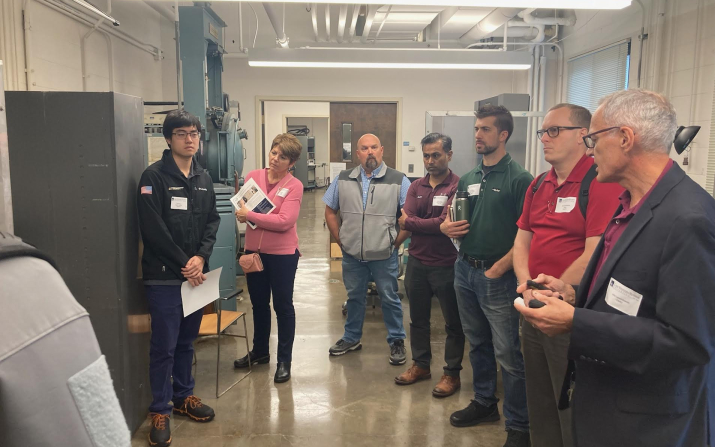Industry members tour CWRU core facilities

When Associate Professor Jennifer Carter acquired a ThermoFisher Apreo 2S (NSF MRI Award: 2018167) as part of a National Science Foundation Major Research Instrumentation grant in 2020, she planned to hold an open house for industry professionals to introduce industry professionals to Swagelok Center for Surface Analysis of Materials’ newest instrument. With COVID restrictions the event had to be delayed until the campus was reopened to visitors. When she began planning the event, she saw it as an opportunity to reintroduce local researchers to several of Case Western Reserve University’s core facilities because “so much has changed in how we engage in research service for hire, the equipment available, the strategic thrust of the different core facilities.”
What hasn’t changed is that SCSAM engages regularly with the North East Ohio research community. In Fiscal Year 2022, SCSAM, of which Carter is Faculty Director, engaged with 12 nonprofits and 24 companies, resulting in about 50% of their annual income. “SCSAM is unique from other CWRU core facilities because they do much more service for hire work for external industry than other core facilities,” said Carter. “When I decided to hold the open house, I wanted to motivate industry to come engage with faculty in research and show how the combined capabilities in the CWRU core facilities provide a unique opportunity to engage across many aspects of materials research and development.”
On September 22, fifty individuals from twenty companies throughout Cleveland, Akron and Pittsburgh came to the CWRU campus to tour SCSAM, the MORE Center, the Advanced Manufacturing and Mechanical Reliability Center, the Solar Durability and Lifetime Extension Center and CWRU’s newest core facility, the UL Fire and Combustion Lab. With the potential investments in Ohio integrated chip manufacturing, it is a really exciting time to show off the thin-film processing capabilities on campus, and the MORE center is once such location. The AMMRC has a 35-year history of working with industry professionals and has recently taken ownership of nearly $1 million dollars worth of donated equipment, SDLE has done more research agreements with industry and with the NSF IUCRC award in materials data science, it was an opportunity to introduce the centers focus beyond solar. Finally, she wanted to provide an opportunity for the newest core facility, UL Fire and Combustion Lab, to engage in discussions with the polymer industry, the largest in Ohio. The CWRU-UL lab might be the only precompetitive site in North East Ohio for conducting UL standard fire safety testing.
Case School of Engineering students at the undergraduate and graduate level served as tour guides, something Carter believed would benefit both the students and the professionals. “To pull off an event like this, you need lots of hands on deck, plus industry wants to engage with the student pipeline,” said Carter. Some of the student tour guides told Carter that they’d never seen some of the facilities, such as Jackson Smith, a BS/MS student in the Department of Materials Science and Engineering.
"I had a great time seeing all of the labs because I had not been in most of them before,” said Smith, who primarily researches in AMMRC. “I always love to learn more about other disciplines and the cool labs on campus. It's easy to get stuck focusing on your own work but seeing others work always fosters new collaborations and inspires new ideas.”
Another AMMRC researcher, Ph.D. candidate Austin Ngo, visited several of the facilities for the first time and appreciated the opportunity to make new connections in the engineering field. "It was a great opportunity to meet industry engineers and learn what analytical instruments and methods they are interested in using," he said.
The day began with coffee and donuts in Nord Hall, during which Carter welcomed guests, thanked GLEI for organizing, and ThermoFisher for sponsoring the event and NSF for funding the MRI program. She provided an overview of the university research organization and the role of core facilities and the value of engaging with individual faculty and the different Research institutes when the correct faculty is unknown. Chris Zorman, Associate Dean for Research in the Case School of Engineering, also spoke, pointing out that the new CWRU President and Vice President for Research want to grow the university’s research portfolios to better support and engage with the local community. After the initial welcome, guests were divided into six groups for their tours.
As the groups rotated through the facilities, Carter walked guests through SCSAM. “In every tour, at least one person said they were seeing a capability they didn’t know we had,” she said.
Raymond Wieser, a Ph.D. candidate in Materials Science and Engineering, gave visitors an overview of the SDLE Center. "It was a great privilege to meet and discuss cutting edge research opportunities with Industry Partners," said Wieser. "Collaboration between academia and industry allows for adoption of cutting edge research techniques into standard industrial practices."
After the tours, everyone reconvened in Nord, where SCSAM Executive Director Jeffrey Pigott told guests about how to contact each core and establish an ilab account. Then lunch was served, during which Carter overheard “great discussions between industry partners and directors of core facilities.”
"I was very excited to see depth of engagement within industry representatives, as well as breadths of possible projects that were brought up,” said Carter. “Everyone was very excited to learn about different opportunities for research.”

